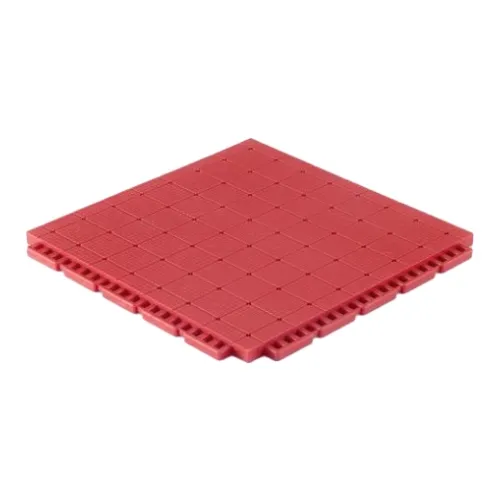Outdoor Plastic Flooring Tiles Durable, Weather-Resistant & Easy Install
- Innovative material properties for all-weather durability
- Comparative analysis of leading manufacturers
- Customization solutions for project-specific requirements
- Specialized applications in commercial and residential settings
- Key factors influencing installation success
- Technical maintenance considerations
- Selection framework for outdoor plastic flooring tiles

(outdoor plastic flooring tiles)
Transform Your Outdoor Spaces with Plastic Flooring Tiles
Modern outdoor plastic flooring tiles represent a revolutionary surface solution engineered for superior all-weather performance. These interlocking systems maintain structural integrity across temperature extremes from -40°F to 170°F (+180°F during peak exposure), significantly outperforming traditional materials like wood or concrete. Advanced polymer formulations incorporate UV stabilizers that resist fading for 10,000+ hours of direct sunlight exposure without significant color degradation. The honeycomb support structure beneath the surface distributes weight efficiently, handling loads exceeding 5,000 psi without deformation.
Unmatched Technical Advantages and Durability
Engineered polymers enable these outdoor tiles to achieve industry-leading durability metrics that surpass conventional alternatives. Unlike wood decking that requires annual sealing, plastic flooring tiles maintain performance for 20+ years with zero protective treatments. Critical technical specifications include:
- Hydration resistance: 0.03% water absorption rate prevents freeze-thaw damage
- Slip resistance: Surface textures achieve DIN 51130 R11 classification (39° incline safety rating)
- Thermal expansion: 0.0015 in/in/°F coefficient minimizes seasonal gapping
Comparative Analysis: Leading Manufacturers in the Market
| Brand | Product Series | Material Composition | Tile Size (mm) | Load Capacity (psi) | UV Resistance | Warranty (years) |
|---|---|---|---|---|---|---|
| TerraTile Pro | OutdoorX HD | Recycled PP + HDPE | 500x500 | 5,600 | Class 1 | 25 |
| FlexiPave | All-Weather Matrix | Virgin PVC + EVA | 330x330 | 4,800 | Class 2 | 15 |
| DuraDeck | Commercial Shield | Composite Polymer | 400x400 | 6,200 | Class 1 | 20 |
Tailored Solutions for Diverse Outdoor Environments
Project-specific requirements drive specialized configurations beyond standard products. Coastal installations typically incorporate enhanced salt resistance through polymer alloys with 25-30% higher corrosion inhibitors. Municipal playground projects utilize impact-modified formulas achieving ASTM F1292-19 standards for 10-foot fall protection. For hospitality environments, manufacturers offer custom:
- Color match programs with proprietary pigment systems
- Branded inlays within the tile surface
- Integrated drainage channels for pool decks
- Anti-microbial treatments certified to ISO 22196
Real-World Applications and Case Studies
Commercial implementations demonstrate the remarkable versatility of modern outdoor tiles. A major university installed 85,000 sq.ft. across campus walkways, eliminating $28,000/year in concrete repair costs while improving ADA compliance. Resort developers reduced pool deck surface temperatures by 38°F compared to traditional pavers. Notable deployments include:
- Marine terminals withstanding constant salt spray exposure
- Rooftop dining areas enduring 150+ freeze/thaw cycles annually
- Emergency vehicle access lanes maintaining traction in downpours
- Amusement parks handling 2M+ visitor footsteps yearly
Installation Insights and Maintenance Considerations
Proper substrate preparation remains critical for optimal performance. Most systems require <1/8" per foot slope gradient for drainage and a compacted aggregate base with 95% Proctor density. Modular designs accommodate thermal movement through interlocking joints engineered with 0.2" expansion buffers. Maintenance protocols differ significantly from traditional surfaces:
| Maintenance Activity | Frequency | Traditional Wood | Plastic Tiles |
|---|---|---|---|
| Cleaning | Seasonal | Pressure washing + chemical stripping | Water rinse only |
| Sealing | Annual | Mandatory ($12/sq.ft) | None required |
| Board Replacement | 5-7 years | Complete section removal | Tile-by-tile swap |
Selecting the Ideal Plastic Flooring Tiles for Your Outdoor Area
Three critical factors determine optimal plastic flooring tiles selection: load frequency, climate severity, and safety certifications. High-traffic commercial entries demand reinforced edges with 5000+ psi ratings, while residential patios prioritize aesthetic options. Northern installations require polymers with -60°F cold-crack resistance. Leading suppliers now provide material test reports confirming compliance with:
- ASTM E303 slip resistance standards
- CAL 117 fire safety requirements
- CRI Green Label Plus emissions certification
- ISO 14064 carbon footprint validation

(outdoor plastic flooring tiles)
FAQS on outdoor plastic flooring tiles
Q: What are the benefits of using outdoor plastic flooring tiles?
A: Outdoor plastic flooring tiles are durable, weather-resistant, and low-maintenance. They provide a slip-resistant surface and are designed to withstand UV exposure and temperature changes. Installation is quick and often requires no specialized tools.
Q: Can plastic flooring tiles for outdoor use handle heavy foot traffic?
A: Yes, high-quality outdoor plastic flooring tiles are engineered to endure heavy foot traffic and outdoor elements. Their interlocking design ensures stability, and materials like polypropylene enhance longevity. Regular cleaning maintains their appearance and functionality.
Q: How do I install outdoor tiles made of plastic?
A: Most plastic outdoor tiles feature interlocking systems for easy DIY installation. Ensure the ground is clean and level before snapping tiles together. No adhesives or grout are typically required, saving time and effort.
Q: Are outdoor plastic tiles suitable for wet or humid environments?
A: Yes, outdoor plastic flooring tiles are water-resistant and ideal for wet areas like pool decks or patios. Their design prevents water pooling, and anti-slip surfaces enhance safety. They also resist mold and mildew growth.
Q: Can plastic flooring tiles be used on uneven surfaces?
A: While outdoor plastic tiles work best on flat surfaces, some textured or adjustable options adapt to minor unevenness. For severely uneven ground, leveling the area first is recommended to ensure stability and aesthetics.
-
Commercial Parquet Flooring: Considerations of Aesthetics, Practicality, And SustainabilityNewsApr.15,2025
-
PVC Sports Flooring: Performance, Applications, And Development TrendsNewsApr.15,2025
-
PP Interlocking Floor: a Paving Solution That Combines Functionality and SustainabilityNewsApr.15,2025
-
Plastic Flooring Tiles Outdoor: Practicality, Sustainability, And Development ProspectsNewsApr.15,2025
-
On the Application of PVC Flooring for Badminton Court in Badminton VenuesNewsApr.15,2025
-
Commercial Wood Flooring: the Balance Between Aesthetics, Functionality, And SustainabilityNewsApr.15,2025
-
The Ultimate Guide to Futsal FlooringNewsMar.27,2025

